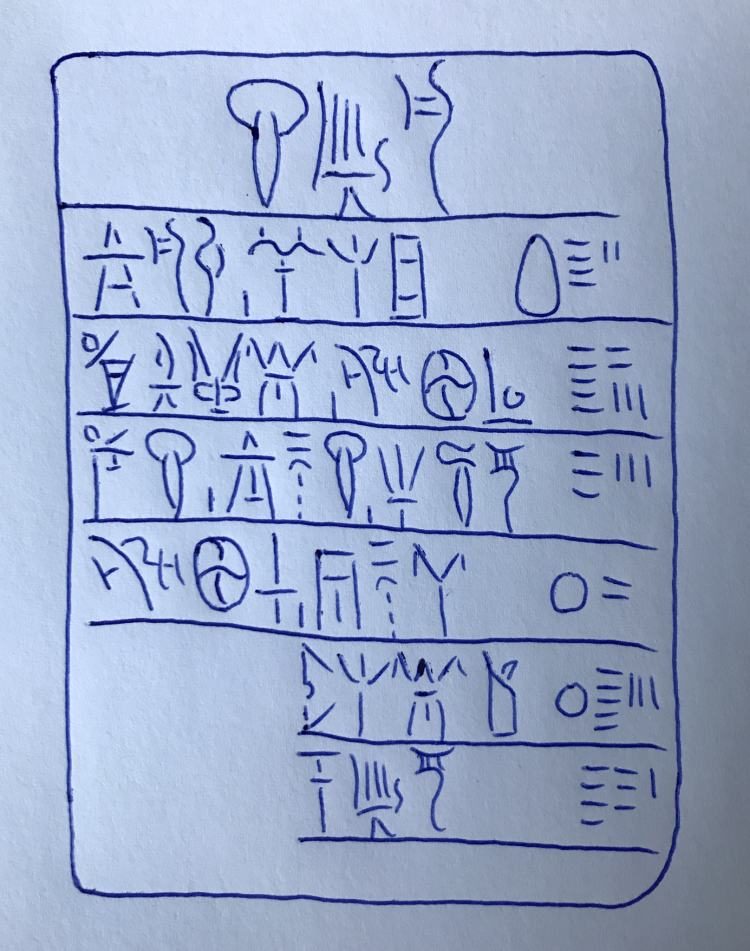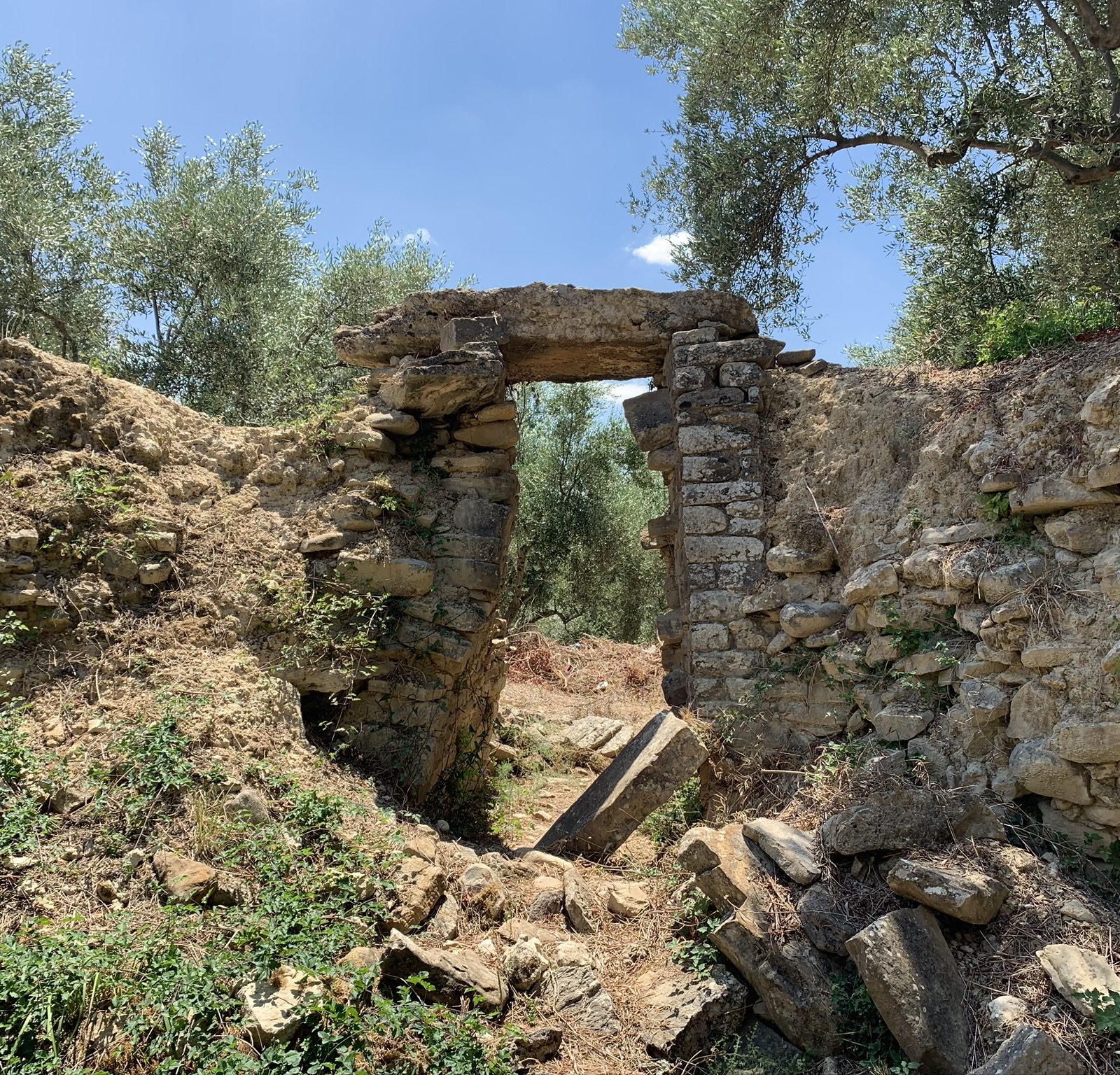There are few things in life more consistently delightful than waking on Easter morning to a house full of chocolate eggs. As such, I rose early today, and scampered down the stairs in excitement of what bounty might await me. As I turned the corner at the landing, I could tell that my hopes were not to be disappointed: on the table sat a basket, ready to be filled as I found the eggs about the house. As I drew nearer, though, and got a better look at the basket, I realized there was something in it already – a slab of chocolate, rectangular, its surface oddly uneven. Leaning in, I knew what I must be seeing, but could scarce believe it – carved into the chocolate tablet were the curvilinear glyphs of the Linear B script.
With what I will insist was remarkable grace, I turned and sprang back up the stairs to find grab my phone and thus photograph the marvelous discovery. But as I rounded the landing again, and my eyes sought the basket again, they were caught instead by the door swinging shut behind what (for all the world) looked like the cotton puff of a rabbit’s tail. Struck with a strange dread, my eyes turned back to the basket – and found it empty.
Baffled by the course of events, I sat down at the table and – thoughts of eggs banished – grabbed a pad of paper. Still half in a daze, my hand traced the lines burned in my brain, and I soon found myself starting at what I was certain (though I know not how) was an accurate reproduction of the chocolate monster I was so sure I had not imagined. Soon enough I was distracted by the promise of eggs, and the basket was eventually full of less inscribed but (presumably) no less delicious chocolate. Eventually, though, the drawing was before me again, and throughout the day I was able to make (I think) some sense of what it said. I share now the results of my pondering:

.1 ko-no-so
.2 e-so-do qo-re-ja OVUM 42
.3 ki-ri-ma-ke me-ga-ra 73
.4 mu-ko pi-na-ko i-qo-jo 33
.5 me-ka-ro wa-na-sa 120
.6 pe-re-ke-o 153
.7 to-no-jo 71
ko-no-so: This is transparently a reference to Knossos, in either the nominative (Κνωσός) or dative/locative (Κνωσῷ); the sense is much the same either way. The increased size of the writing in this line finds a parallel of sorts in the oversized pu-ro of PY Tn 316. e-so-do qo-re-ja: this ought to be something like ἔ(ι)σοδος γʷόρεια (= βόρεια), “northern entrance,” though given the dative of .3 we should prefer ἐ(ι)σόδῳ γʷορείᾳ, representing the recipient. OVUM 42: the logogram is new, but that it represents an egg is, I think, certain (though perhaps I simply have them on the brain today); the resemblance is certainly striking. Following the conventions of Mycenology, I have rendered it in Latin, unabbreviated as is elsewhere the case with four-letter words (cf. OVIS, sheep). If I am correct in this, it seems that 42 eggs were delivered to the “northern entrance” of the Palace at Knossos.
ki-ri-ma-ke me-ga-ra: this must almost certainly be read as κλίμακει μεγάλᾳ (Att. κλίμακι μεγάλῃ), “big ladder/staircase.” Given that we should expect a room or area of the palace, staircase must seem much more likely. The following numeral (73) must pick up on the egg logogram in the line above; such short-hand is used in other tablets, and this is in fact not the only instance of such a phenomenon on this tablet (cf. lines .6 and .7). mu-ko pi-na-ko i-qi-jo: the obvious interpretation is remarkable: μυχῷ πινάκων ἰκκʷίων, “store-room of the chariot tablets.” This would be the first reference in the Linear B corpus to the tablets themselves (πινάκων). The room, perhaps an archive, received 33 eggs. me-ka-ro wa-na-sa: μεγάρῳ ϝανάσσας, “the chamber (megaron) of the queen.” Given the significance attached to megara in Mycenaean archaeology, the attestation of the term is remarkable, though as we shall see its usage seems to have been fairly flexible. It must be a suitably large room, as it is apportioned 120 eggs. pe-re-ke-o: presumably πελεκέως, genitive of πέλεκυς, “double axe.” Given the deficient syntax and layout of the tablet, it seems that μεγάρῳ should be understood here too: the “chamber/hall of the (double?) axes”? The attestation of πέλεκυς is also a strike against those who assume a form of λάβρυς was the “Minoan” term for double axe or underlies the enigmatic da-pu2-ri-to-jo. Another apparently large room, it received 153 eggs. to-no-jo: θορνοῖο (Att. θρονοῖο), “throne”, again apparently picking up me-ka-ro. “The chamber of the throne?” Smaller than the other megara, it was only given 71 eggs.
The tablet seems, therefore, to be recording the allotment of eggs to various rooms of the Palace of Knossos. A palatial interest in eggs has never been recorded before; and the numbers are odd. Perhaps this was not a palatial record after all; given the circumstances under which it was found and disappeared, it is hard to avoid thoughts of eggs left in the night, and Minoans engaged in their own enthusiastic morning hunt.

Eggscellent (sorry). ka-ro pa-ka/ καλό Πάσχα!
LikeLiked by 2 people
Thanks! And to you!
LikeLiked by 1 person
Love it !!
LikeLiked by 1 person
Reblogged this on KORYVANTES Association published work and commented:
RE: .2 e-so-do qo-re-ja OVUM 42
To me, this does not look like the ideogram for sheep at all. But once again, I am probably dead wrong. Plus you say:
OVUM 42: the logogram is new, but that it represents an egg is, I think, certain (though perhaps I simply have them on the brain today)
Stranger than fiction to me. I think it is just the 142, which the scribe scribbled as an ovoid, instead of a circle. But you are probably right, and I am wrong. Still, this makes me very uncomfortable. The rest of your translation makes eminent sense.
Thanks!
Richard
LikeLike